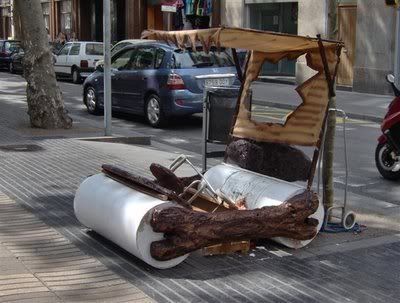
Posted on 11/23/2007 1:52:00 PM PST by rawhide
Companies are manufacturing kites the size of football fields that can be deployed with a flexible cable from the bows of huge vessels. Rising nearly 1,000 feet above sea level, they catch winds that are up to 50 percent stronger than at the surface and help pull the behemoths along.
The kites are a throwback to a simpler era when ships relied solely on wind. But these days they also address the very new-age worry of climate change.
Proponents say kites, which let captains throttle back their ship's diesel engines, will help slash fuel consumption by as much as 50 percent under optimal conditions.
Cutting back the amount of fuel burned also curbs emissions of greenhouse gases. By some estimates, the shipping industry discharges twice as much carbon dioxide as air traffic.
One major player in the kite business, SkySails in Hamburg, Germany, initially developed kite-propulsion systems for luxury yachts in 2001. Today the systems are being installed on cargo ships as well.
The first such ship to be outfitted with SkySails will be the 460-foot Beluga SkySails belonging to the Bremen, Germany-based shipping company, the Beluga Group. It's set to make its maiden voyage on Dec. 15, hauling windmills from Esbjerg, Denmark to Houston, Texas.
In a written statement, Beluga said, "a decrease of fuel consumption as well as a cutback of the emission of harmful greenhouse gases on sea by 10 percent to 20 percent is the expected outcome of the pioneering application of SkySails."
Looking toward the future, SkySails is nothing if not ambitious.
(Excerpt) Read more at ajc.com ...

Cool.
Way cool.
What’s old is new again...
Smart ecoomics. And yes, way cool.
Hell, I coined a new phrase. LOL eco-omics = economics
--I don't think that's the only hurdle on the way to 50% (or 15%) fuel savings--

Anything to save fuel costs is good. However, to use as a justification that it would reduce carbon emissions, is ridiculous. Man’s contribution to the total earth’s CO2 is a drop in the bucket.
Man’s contribution to green house gases is 3.298%. This figure does not include water vapor, which is a huge greenhouse gas that most Global Warning Nuts don’t talk about. Also, these nuts will not describe how some greenhouse gases cause more affect on Global Warming than others. CO2 is a minor green house gas when it is compared to water vapor and methane. And, methane is caused by bacteria. Are we going to go after the bacteria?
We can demand that all bacteria have sails.
I would think a more practical idea would be an automatic retractable vertical foil of some kind. And 5-10% savings would be great. Enough to amortize the investment in a couple years.
—yep—I believe those would be called “sails”—and IIRC, there have been designs put forth for modern versions of the same—
Bingo!
Here's a modern version:

My thought would be to incorporate vertically retractable versions which would be much more moderate in their ambitions, meant merely for supplementing power. Small enough to be retrofitted.
Great. A new signal to pirates that a great bounty is on the way.
Works great as long as you are headed downwind.
Modern vertical sails have been around a long time, look thru old Popular Science mags. I even invented a triangular sail that is mostly used as a sail, but also spins on the vertical axis, around the mast, for electric power generation. The sail half coming upwind hinges on the diagonal stay line(cable), thus min drag; the other half sail slaps against the mast and cross spar(inner side/bottom)and is face-on going downwind, thus max drag. Directly downwind it suddenly swings from on the mast to on the diagonal stay line(cable), trailing it edge-on.
This is but a variation of the eggbeater windmill(or savonius rotor) : face-on going downwind/edge-on coming back upwind. Thus, even at anchor this spinning sail is generating wind-to-electric power. The only real PROBLEM is the off center force(from the vertical mast)on the downwind half sail, that in turn creates a gyroscopic wobble on the whole ship. That can in part be solved w/a second sail-mill rotating at the same speed(CCW vs CW)but still the horizontal roll is there around the ship’s mass-axis. I’ve got a paddle-solution for that too.
Another solution : have two rows of side propellers that divide the otherwise on-coming bow wave into 2 side streams that go out and around the freighter. That means a TROUGH in front(and crest behind), thus the ship becomes a surfboard riding on its own self-created surf wave, constantly sliding forward by gravity. No bow wave(C)and transom wave(T); you’ve REVERSED the usual C/T wave forces to T(front)/C(back). Thus the usual N vector on the curved bow, being further divided into s(side=good)and f(front=bad), is REVERSED because now the f sub-vector is pointing rearward. I call it the “nina effect” : you only PULL the water out of the way that you need to, no bow wave(wasted energy)washing up on distant shores miles away.
Ah well, that’s but 2 of my many marine propulsion inventions, the others are much faster; but nobody was interested....
Disclaimer: Opinions posted on Free Republic are those of the individual posters and do not necessarily represent the opinion of Free Republic or its management. All materials posted herein are protected by copyright law and the exemption for fair use of copyrighted works.